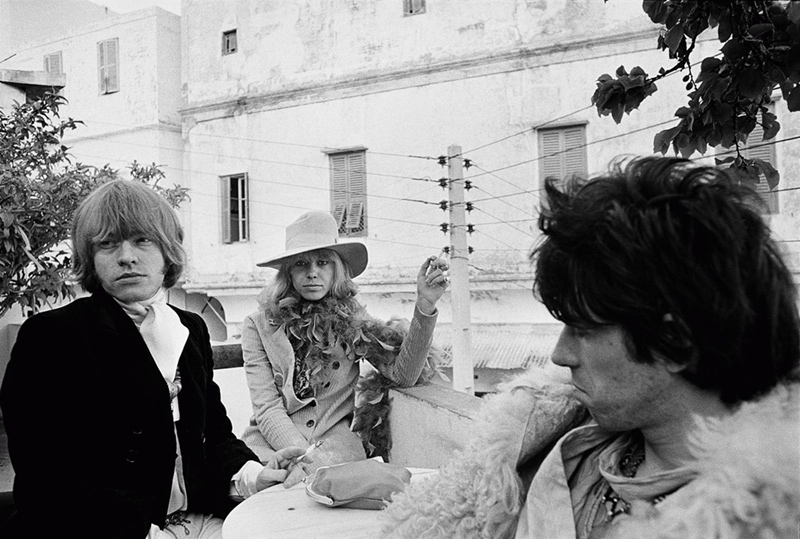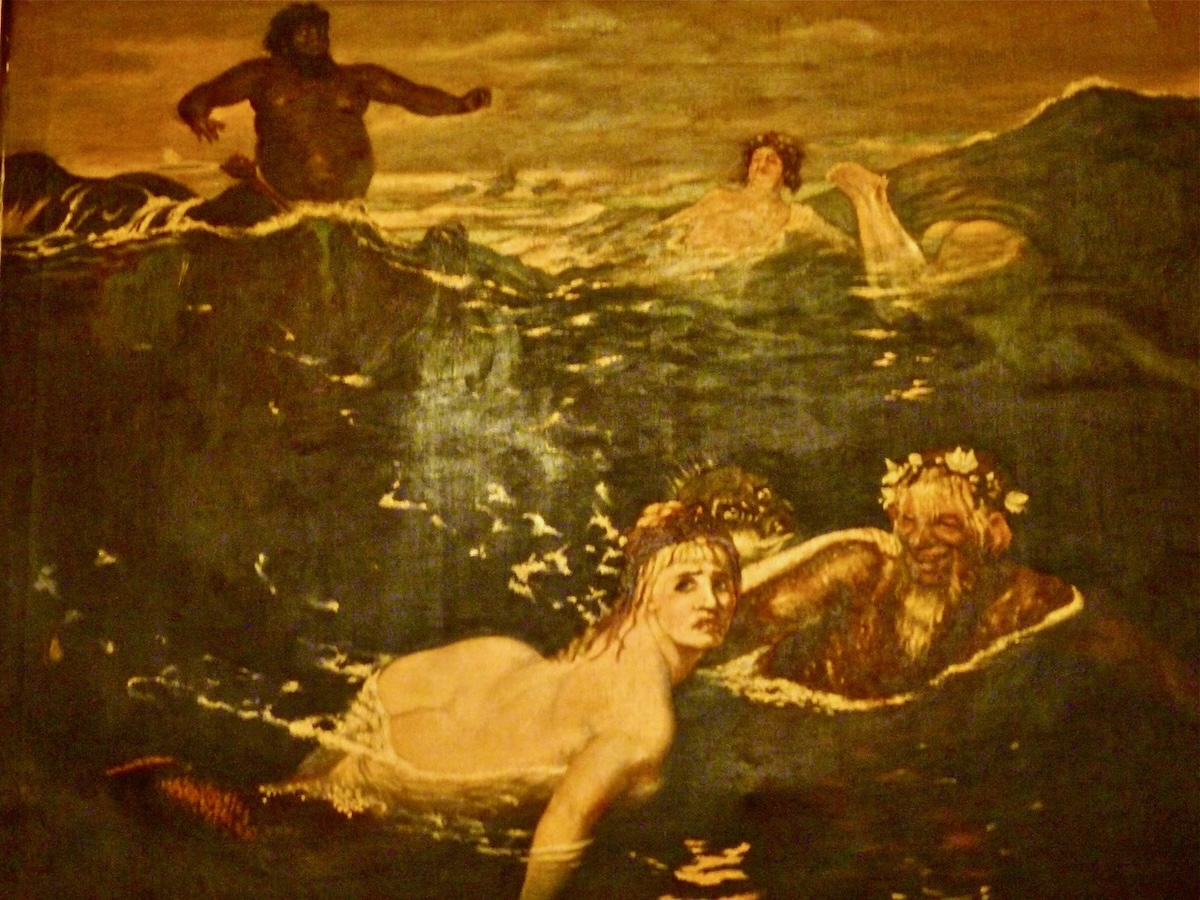
I went to see the new Anita Pallenberg doc Catching Fire: The Story of Anita Pallenberg last week shortly after it opened at the IFC Center here on 6th Avenue, the first show of the day at the ungodly hour of 11:50 am. About five souls only collected in the lobby before the management opened the doors to the main theater—obvious hardcore fans of the Rolling Stones, more or less from my g-g-g-g-generation, knowledge brothers and sisters. Fellow old souls, we cast a commiserating glance at each other, waiting to go into the main theater when one of them whispered conspiratorially across to me: "Only people of a certain age know who Anita Pallenberg is" (was)—historical memory if not yr basic continuum of knowledge post-iPhone having been fucked into a cocked hat/relegated to the slag heap of history ("Do you remember your President Nixon?" sang David Bowie circa '75, only a year after Nixon resigned. Indeed. Do you remember what you even had for lunch yesterday?).
Then it was time to bear witness to the blazing trajectory of Anita Pallenberg, Rock Chick Uber Alles, in a league of her own you could say, a powerful female shaman in her own right, a Lilith-figure who had Brian and then Keith with a side order of Mick, who even out-did Marianne Faithfull in the Ultimate Stones Bad Girl pantheon, a (dis)Honor Roll whose ranks stretch back to the early '60s and roll on to the last syllable of recorded time and include chanteuse Nico (knocked up and abandoned by Brian), singer/actress Marsha Hunt (knocked up and abandoned by Mick), German tv presenter/left-wing poster girl Uschi Obermaier (who had the signal pleasure of tearing Keith's earring out of his ear with her teeth during wild sex, leaving him and his bloody earlobe glued to the pillow when he came to next morning)—with special mention going to Mandy Smith who began an affair with Bill "Perks" Wyman at age 13—Bill enjoyed his perks!—and finally wed him 5 years later when she came of legal age in a marriage that lasted only 23 months.
This is a very long and comprehensive documentary skillfully assembled by Alexis Bloom and Svetlana Zill, and it's worth a look, especially if you're a fan of the Stones. If not, you may come to gawk and stay. It has a copious amount of (to me) never-before-seen footage of the home movie variety, which looks pretty damned good considering its source, no doubt courtesy of Keith's two kids by Anita—Marlon and Angela Richards. Both come off as very well-spoken, sensitive, and sympathetic people who experienced a real amount of damage growing up in the wake of the Stones juggernaut and their absentee parents's antics and came out the other side intact (phew!).
Now, the Stones have always been my favorites ever since the immortal opening bluesy guitar riff of The Last Time (composed and played by Brian Jones) came wafting over the airwaves and cast its hypnotic spell—and having seen them live in 1965 in my little town of Syracuse I became a stone zealot. Over the years, I've read almost every book about them, beginning with the 1965 Bantam paperback Our Own Story by the Rolling Stones as We Told It to Pete Goodman (UK music journalist Peter Jones in real life). I also sat through myriad HBO live specials and theatrical concert docs, including rarities like British Pathe's 1964 short subject Rolling Stones Gather Moss (I saw it in a movie theater). So yeah, eventually, I kinda knew the whole extended Anita episode pretty well, all the highs and lows. You could do worse by starting here: https://en.wikipedia.org/wiki/Anita_Pallenberg

Here, her story is fleshed out to the nth degree and—clocking in as it does for nearly one hour and fifty minutes, but it feels like three—they easily could have trimmed twenty minutes from it. Still, I am happy Anita is given her due here at last because she comes off on the face of the available evidence as an even stronger, more willful, and forceful Personality than Messrs. Jones, Richards, and Jagger combined. Certainly, none of the Stones radiate anything resembling real Star Power on the big screen when caught off stage, going back to Peter Whitehead and Andrew Loog Oldham's 1966 live-in-Ireland documentary, Charlie is My Darling, where they come off as lumpen proles in the interview sections (as opposed to The Beatles' individual charismatic sparkle throughout A Hard Day's Night ). The Anti-Beatles, eh? But Anita shines in all her film forays. A real-life force of nature, for my money, she is the best thing about Nicholas Roeg and Donald Cammell's 1970 Performance—she absolutely steals the show from Mick.
The narration here is by Scarlett Johanson, who reads chunks from Anita's posthumously discovered autobiographical manuscript entitled (what else?) Black Magic. Her low-key (some would say flat) American accent doesn't work for me, sorry to say—she sounds way too nice. I would have vastly preferred the dulcet accented tones of Eva Green or the husky vocables of Emma Stone on the soundtrack—or better yet, going for true Bad Girl glory, the voice of Asia Argento or Paz de la Huerta—but you can't always get what you want.
Fun Fact/Most Impressive Takeaway: Anita was the great-granddaughter of Swiss symbolist painter Arnold Böcklin, whose canvases contain as much colorful Sturm und Drang as Anita's own storied life. Böcklin specialized in mythological portraits of centaurs, satyrs, and nubile nymphs at play; some of his tableau seem to predict (or at least are not that far afield of) central episodes in Anita's saga. (I actually discovered a knockoff of Böcklin's 1883 masterpiece Playing in the Waves in a smoky pub in Prague some years ago, which on close inspection, has a horned demonic visage Goat Head's Soup-style painted under the top layer of pigment courtesy of the anonymous forger (see below, right under the centaur's outstretched left arm, this painting now hangs in Studio Faust just across the road from the pub in Prague, an excellent recording facility operated by my old friend Richard "Faust" Mader).

True confession: I am kind of burned out on the Stones and their wicked wicked ways at this point in time. I'm told they are still capable of churning out the occasional banger. But I couldn't name one. And I have no desire to sit in a stadium to see them—or anyone, for that matter (well, Paolo Conte—maybe). Can holographic AI performances of the band a la Abba be all that far off?
Basically, "I don't find this stuff amusing anymore" (Paul Simon). I still enjoy their early recordings, particularly the Andrew Oldham-era Stones—but I've stopped actively listening to them. They have become (for me anyway) a tired fossilized cliche, aging poster boys for a decadent rock 'n' roll lifestyle that flourished in what looks now like the Jurassic era, with scant relevance in the current world-historical climate other than as mere entertainment fodder (albeit on a Brobdinagian scale). A nostalgia act, in other words. They're not dangerous anymore. Were they ever, really?? Yes. So dangerous that the UK establishment contrived to try and shut them down by busting 3 of them repeatedly when their influence on youth culture became a perceived subversive threat to authority and the way people thought about things like "petty morals" (to quote Keith in the dock of the Old Bailey in 1967). When their very presence on stages (particularly in Eastern Europe) could provoke riots.
The beginning of the end of my fascination with the Stones began with the Altamont debacle—which, along with Kent State, heralded the death knell of the '60s—and picked up speed right around the time they brought Truman Capote and Lee Radziwill into their entourage on the road with them in '73, when the whole thing became a mega-commodified spectacle—you can get a strong whiff of this sorry-ass rawk 'n' roll circus up close and personal in parts of the suppressed-for-years Robert Frank doc, Cocksucker Blues. Their music stayed strong for a few more albums post-Exile. They could still pump out the occasional world-shaking anthem—but their whole Outlaw persona began to ring hollow. Keith's Life autobiography signaled the end of my Stones infatuation: too many casualties surrounding the group, too much collateral damage, too much bad behavior and by-the-numbers debauchery over too many years. Not impressed. "What else can you show me?" (Dylan).
Still, this documentary is a good start towards shining a light on a powerful female artist in her own right in the Stones menage who was seemingly under nobody's thumb but that of King Heroin—a nasty habit she managed to kick before joining "the choir invisible" (George Eliot). It restores an overall sense of agency (to invoke a current big buzzword) to the "Voodoo Priestess" and "seductive enchantress," as she is referred to in the doc—but it is not exactly a "pretty pretty" (Barbarella) story.
